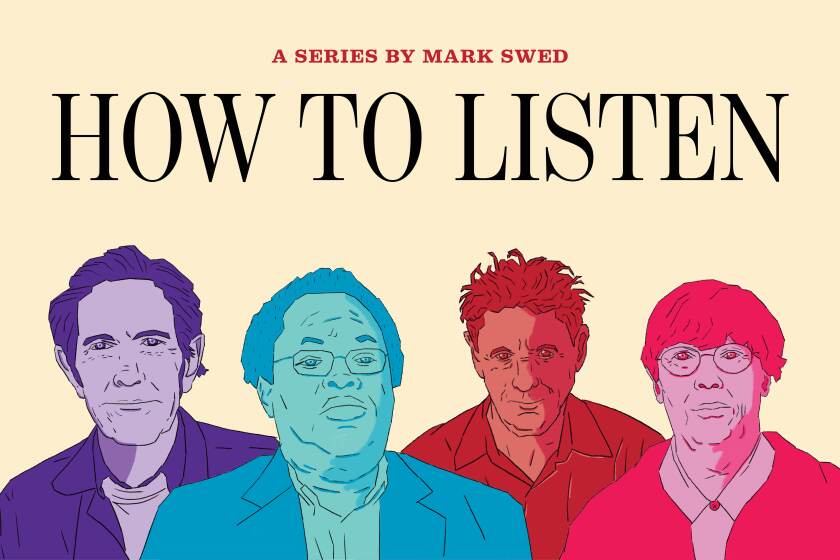How Terry Riley and Kronos Quartet turned the sun’s radiance into the most moving music

Here comes the sun — again.
Alive to a radiant democratic spirit taking hold in Europe and alongside a new appreciation of the natural world, the 40-year-old Joseph Haydn composed six revolutionary string quartets in 1772. The Opus 20 quartets gave independence to the ensemble’s four individual voices, revealed the string quartet potential for uniquely intimate expression and surveyed the wider world as the irrepressibly sneaky Haydn slipped in hidden references to folk song and dance. Their radiance inspired a Dutch publisher to put an etching of the rising sun on the cover of the scores, and they’ve been known ever since as the “Sun” quartets.
A little over 200 years later, a 40-something Terry Riley made his first venture into the string quartet with “Sunrise of the Planetary Dream Collector.” The composer who launched Minimalism with “In C” had over the years become a planetary music pack rat, and he found the string quartet to be a haven for bebop, Bartók, north Indian raga, Ravel, Renaissance vocal music and whatnot.
Riley’s string quartets, in cahoots with the indomitable Kronos Quartet, went on to revolutionize chamber music once more. It was in no small part thanks to Riley’s influence that Kronos found its voice and its own planetary mission of making the string quartet a universal medium, amenable to a vaster range of musical genres, nationalities, ethnicities and styles than anyone thought possible. The result has led to the commission of more than 1,000 works from composers all over the globe.
In the end, no composer alive has more gratifyingly or influentially proposed how to listen than Terry Riley. No ensemble in history has changed how we might listen to music as has Kronos. And no string quartet since Haydn’s Opus 20 set has been as radiantly “Sun”-soaked as Riley’s “Sun Rings.” It is, then, with this profound peer into the night sky to understand the travails of our planet, that we bring “How to Listen” toward a conclusion.
“Sun Rings” asks us to listen to messages from the solar system that could help us heal our pandemic-plagued and climate-changed Earth. Those messages are known in plasma physics as whistlers, descending tones that are generated by lightning strikes in interplanetary space, including the Earth’s atmosphere. They can be captured in a frequency range audible to our ears as breathily seductive, shrieking and everything between. Music of the spheres may be a concept as old as human imagination and whistlers have been rudimentarily known about for some time, but it has taken a sanguine modern shaman of the string quartet to expose their musicality.
The impetus for “Sun Rings” was a modest commission by NASA, which asked Kronos for a space-centric string quartet on the occasion of the 25th anniversary of the space agency’s launch of the Voyager probes in 1977. They included plasma physicist Donald Gurnett’s experiments in which he captured the sounds of whistlers in Jupiter’s atmosphere, and their mysterious hissing sounds reminded Riley of his own work with tape music in the Bay Area in the early 1960s. He went back into the studio to electronically enhance the space sounds that Gurnett gave him and that would accompany the strings.
Coronavirus may have silenced our symphony halls, taking away the essential communal experience of the concert as we know it, but The Times invites you to join us on a different kind of shared journey: a new series on listening.
I spent a couple of hours with Gurnett in his office at the University of Iowa in 2002 the morning of the “Sun Rings” premiere, and I left filled with a sense of the sheer marvel of the universe. Riley told me he spent a day with the scientist on their first meeting two years earlier, which made the planetary dream collector dream anew. But it was not until 9/11, which happened as Riley was composing “Sun Rings,” that he understood that the essence of “Sun Rings” would have to be about considering the Earth from the broad perspective of space.
The warring claim from all beliefs that God was on their side most inspired Riley to add to his musical duties of planetary dream collector those of planetary prayer collector and added a chorus that could enunciate those prayers in their many languages, just as he used many musical languages in all his quartets. He further found his path though poet and novelist Alice Walker’s response to the terrorist attack, that we must strive to be “One Earth, one people, one love.” Outer space became for Riley — as it does for all astronauts, real ones and the rest of us — a place to look down at ourselves and our environment.
Before long, “Sun Rings” outgrew NASA’s original commission for a 20-minute quartet and became an evening-length project. It included background space sounds, some triggered via electronic sensors by the string players, a chorus gathered locally for each performance and an elaborate visual design by Willie Williams, who is best known for illuminating big rock shows. Added commissioners, such as the University of Iowa and the Philharmonic Society of Orange County, helped to fund it. Kronos has since taken the work around the world.
The 10 movements of “Sun Rings” are a kind of mythical voyage. Riley has always had a fondness for offbeat (and Beat Generation) titles. The sun has no rings; Riley’s title comes from the fantasy of Swiss outsider artist Adolf Wölfi. The sounds of whistlers whorl overhead at the start, in “Hero Danger,” as the four members of the quartet toss a carefree theme around, as if in anticipation of a great adventure. Grooving through the “Beebopterismo,” they arrive at “Planet Elf Sindoori,” Venus-like in its beauty. Jupiter gets a sloppy, wet whistler kiss. “Prayer Central” is the centerpiece, a polyphony of prayers. “One Earth, One People, One Love” is the final destination.
All of this makes for essential listening as we end our dazed year of the pandemic. Our attention has been, as it must be, on our diseased planet and its terrible fires, on our social upheavals, on our lives upturned and lost. We’ve mistrusted science when we’ve wanted to not worry about consequences, and yet we expect it to minister to our needs and, if we’re sick, cure us.
But how quickly we’ve forgotten how slowing our activity and reducing pollution during the worldwide lockdown unlocked our view of the heavens thanks to the clearest skies in eons. In April, we also got further notice of music of the spheres with the capturing of radio waves by a Canadian radio telescope with the appropriate acronym of CHIME. We’ve been sending missions into space all year. One of NASA’s became the first to scoop up dirt from asteroid and bring it home. China’s unmanned Chang’e 5 moon launch returned on Dec. 16, Beethoven’s 250th birthday, with our first samples of moon dust from its dark side.
What hasn’t gotten widespread attention but most of all offers cause to rejoice is the Borexino Experiment in L’Aquila, Italy, where this year neutrinos from the sun were discovered that hold clues into the processes that power the sun. Marshall these neutrinos and perhaps they promise solutions for our own excessive energy needs.
Could this underground laboratory in central Italy be Prayer Central?
“Sun Rings” shine on.
Starting points
It took nearly two decades for the Kronos Quartet to record “Sun Rings.” Nonesuch decided not to make a video. (You can find performance footage on YouTube.) But let the music speak for itself, and it does utterly. The recording is lovingly made (I can attest to that, having helped out slightly with a program note), and it won a Grammy this year for its exceptional engineering.
Nonesuch has been Kronos Central for most of the quartet’s existence, and on the occasion of Riley’s 80th birthday five years ago, the label put out a one-CD selection and a box set of all of Kronos’ Riley recordings.
Meanwhile, Haydn’s “Sun” quartets are well represented on recordings, most recently with all-guns-firing performances from Stanford University’s St. Lawrence String Quartet and an alluringly eloquent reading from the exquisite Chiaroscuro Quartet.
Critic Mark Swed’s “How to Listen” series will come to a close with a final installment posting Thursday at latimes.com/arts and appearing in the Sunday Calendar section. The series archive is at latimes.com/howtolisten. You can support Mark’s work with a digital subscription.
More to Read
The biggest entertainment stories
Get our big stories about Hollywood, film, television, music, arts, culture and more right in your inbox as soon as they publish.
You may occasionally receive promotional content from the Los Angeles Times.












